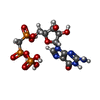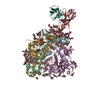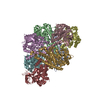+ Open data
Open data
- Basic information
Basic information
| Entry | Database: PDB / ID: 6wsl | |||||||||
|---|---|---|---|---|---|---|---|---|---|---|
| Title | Cryo-EM structure of VASH1-SVBP bound to microtubules | |||||||||
 Components Components |
| |||||||||
 Keywords Keywords | PROTEIN BINDING / Microtubule / Posttranslational modification / Detyrosination / Vasohibin | |||||||||
| Function / homology |  Function and homology information Function and homology informationregulation of metallopeptidase activity / tubulinyl-Tyr carboxypeptidase / tubulin-tyrosine carboxypeptidase / netrin receptor binding / dorsal root ganglion development / Post-chaperonin tubulin folding pathway / axonemal microtubule / negative regulation of lymphangiogenesis / Cilium Assembly / regulation of cellular senescence ...regulation of metallopeptidase activity / tubulinyl-Tyr carboxypeptidase / tubulin-tyrosine carboxypeptidase / netrin receptor binding / dorsal root ganglion development / Post-chaperonin tubulin folding pathway / axonemal microtubule / negative regulation of lymphangiogenesis / Cilium Assembly / regulation of cellular senescence / cytoskeleton-dependent intracellular transport / organelle transport along microtubule / Microtubule-dependent trafficking of connexons from Golgi to the plasma membrane / Carboxyterminal post-translational modifications of tubulin / forebrain morphogenesis / Intraflagellar transport / Sealing of the nuclear envelope (NE) by ESCRT-III / cerebellar cortex morphogenesis / glial cell differentiation / dentate gyrus development / Formation of tubulin folding intermediates by CCT/TriC / neuron projection arborization / flagellated sperm motility / Gap junction assembly / Prefoldin mediated transfer of substrate to CCT/TriC / Kinesins / COPI-independent Golgi-to-ER retrograde traffic / Assembly and cell surface presentation of NMDA receptors / response to L-glutamate / pyramidal neuron differentiation / centrosome cycle / negative regulation of endothelial cell migration / labyrinthine layer blood vessel development / peptidase activator activity / COPI-dependent Golgi-to-ER retrograde traffic / smoothened signaling pathway / regulation of synapse organization / axon development / negative regulation of endothelial cell proliferation / startle response / motor behavior / response to tumor necrosis factor / Recycling pathway of L1 / locomotory exploration behavior / microtubule polymerization / negative regulation of blood vessel endothelial cell migration / protein secretion / regulation of angiogenesis / sperm flagellum / response to mechanical stimulus / RHO GTPases activate IQGAPs / microtubule-based process / Hedgehog 'off' state / intercellular bridge / COPI-mediated anterograde transport / Activation of AMPK downstream of NMDARs / condensed chromosome / metallocarboxypeptidase activity / negative regulation of protein ubiquitination / Mitotic Prometaphase / EML4 and NUDC in mitotic spindle formation / Loss of Nlp from mitotic centrosomes / Loss of proteins required for interphase microtubule organization from the centrosome / peptide binding / Recruitment of mitotic centrosome proteins and complexes / MHC class II antigen presentation / homeostasis of number of cells within a tissue / Recruitment of NuMA to mitotic centrosomes / Anchoring of the basal body to the plasma membrane / axon guidance / cellular response to calcium ion / HSP90 chaperone cycle for steroid hormone receptors (SHR) in the presence of ligand / Resolution of Sister Chromatid Cohesion / negative regulation of angiogenesis / AURKA Activation by TPX2 / adult locomotory behavior / cell periphery / Translocation of SLC2A4 (GLUT4) to the plasma membrane / filopodium / neuromuscular junction / intracellular protein transport / RHO GTPases Activate Formins / synapse organization / recycling endosome / cerebral cortex development / PKR-mediated signaling / visual learning / structural constituent of cytoskeleton / response to wounding / microtubule cytoskeleton organization / memory / cytoplasmic ribonucleoprotein granule / neuron migration / apical part of cell / HCMV Early Events / Aggrephagy / The role of GTSE1 in G2/M progression after G2 checkpoint / mitotic spindle / Separation of Sister Chromatids / Regulation of PLK1 Activity at G2/M Transition Similarity search - Function | |||||||||
| Biological species |  Homo sapiens (human) Homo sapiens (human) | |||||||||
| Method | ELECTRON MICROSCOPY / single particle reconstruction / cryo EM / Resolution: 3.1 Å | |||||||||
 Authors Authors | Li, F. / Li, Y. / Yu, H. | |||||||||
| Funding support |  United States, 2items United States, 2items
| |||||||||
 Citation Citation |  Journal: Elife / Year: 2020 Journal: Elife / Year: 2020Title: Cryo-EM structure of VASH1-SVBP bound to microtubules. Authors: Faxiang Li / Yang Li / Xuecheng Ye / Haishan Gao / Zhubing Shi / Xuelian Luo / Luke M Rice / Hongtao Yu /   Abstract: The dynamic tyrosination-detyrosination cycle of α-tubulin regulates microtubule functions. Perturbation of this cycle impairs mitosis, neural physiology, and cardiomyocyte contraction. The ...The dynamic tyrosination-detyrosination cycle of α-tubulin regulates microtubule functions. Perturbation of this cycle impairs mitosis, neural physiology, and cardiomyocyte contraction. The carboxypeptidases vasohibins 1 and 2 (VASH1 and VASH2), in complex with the small vasohibin-binding protein (SVBP), mediate α-tubulin detyrosination. These enzymes detyrosinate microtubules more efficiently than soluble αβ-tubulin heterodimers. The structural basis for this substrate preference is not understood. Using cryo-electron microscopy (cryo-EM), we have determined the structure of human VASH1-SVBP bound to microtubules. The acidic C-terminal tail of α-tubulin binds to a positively charged groove near the active site of VASH1. VASH1 forms multiple additional contacts with the globular domain of α-tubulin, including contacts with a second α-tubulin in an adjacent protofilament. Simultaneous engagement of two protofilaments by VASH1 can only occur within the microtubule lattice, but not with free αβ heterodimers. These lattice-specific interactions enable preferential detyrosination of microtubules by VASH1. | |||||||||
| History |
|
- Structure visualization
Structure visualization
| Movie |
 Movie viewer Movie viewer |
|---|---|
| Structure viewer | Molecule:  Molmil Molmil Jmol/JSmol Jmol/JSmol |
- Downloads & links
Downloads & links
- Download
Download
| PDBx/mmCIF format |  6wsl.cif.gz 6wsl.cif.gz | 445 KB | Display |  PDBx/mmCIF format PDBx/mmCIF format |
|---|---|---|---|---|
| PDB format |  pdb6wsl.ent.gz pdb6wsl.ent.gz | 358.2 KB | Display |  PDB format PDB format |
| PDBx/mmJSON format |  6wsl.json.gz 6wsl.json.gz | Tree view |  PDBx/mmJSON format PDBx/mmJSON format | |
| Others |  Other downloads Other downloads |
-Validation report
| Summary document |  6wsl_validation.pdf.gz 6wsl_validation.pdf.gz | 1.2 MB | Display |  wwPDB validaton report wwPDB validaton report |
|---|---|---|---|---|
| Full document |  6wsl_full_validation.pdf.gz 6wsl_full_validation.pdf.gz | 1.2 MB | Display | |
| Data in XML |  6wsl_validation.xml.gz 6wsl_validation.xml.gz | 61.7 KB | Display | |
| Data in CIF |  6wsl_validation.cif.gz 6wsl_validation.cif.gz | 93.9 KB | Display | |
| Arichive directory |  https://data.pdbj.org/pub/pdb/validation_reports/ws/6wsl https://data.pdbj.org/pub/pdb/validation_reports/ws/6wsl ftp://data.pdbj.org/pub/pdb/validation_reports/ws/6wsl ftp://data.pdbj.org/pub/pdb/validation_reports/ws/6wsl | HTTPS FTP |
-Related structure data
| Related structure data |  21893MC M: map data used to model this data C: citing same article ( |
|---|---|
| Similar structure data |
- Links
Links
- Assembly
Assembly
| Deposited unit | 
|
|---|---|
| 1 |
|
- Components
Components
-Protein , 4 types, 8 molecules AEBFCGDH
| #1: Protein | Mass: 50188.441 Da / Num. of mol.: 2 Source method: isolated from a genetically manipulated source Source: (gene. exp.)  Homo sapiens (human) / Gene: TUBA1A, TUBA3 / Production host: Homo sapiens (human) / Gene: TUBA1A, TUBA3 / Production host:  Trichoplusia ni (cabbage looper) / References: UniProt: Q71U36 Trichoplusia ni (cabbage looper) / References: UniProt: Q71U36#2: Protein | Mass: 50481.520 Da / Num. of mol.: 2 Source method: isolated from a genetically manipulated source Source: (gene. exp.)  Homo sapiens (human) / Gene: TUBB3, TUBB4 / Production host: Homo sapiens (human) / Gene: TUBB3, TUBB4 / Production host:  Trichoplusia ni (cabbage looper) / References: UniProt: Q13509 Trichoplusia ni (cabbage looper) / References: UniProt: Q13509#3: Protein | Mass: 29780.445 Da / Num. of mol.: 2 Source method: isolated from a genetically manipulated source Source: (gene. exp.)  Homo sapiens (human) / Gene: VASH1, KIAA1036, VASH / Production host: Homo sapiens (human) / Gene: VASH1, KIAA1036, VASH / Production host:  #4: Protein | Mass: 7821.939 Da / Num. of mol.: 2 Source method: isolated from a genetically manipulated source Source: (gene. exp.)  Homo sapiens (human) / Gene: SVBP, CCDC23 / Production host: Homo sapiens (human) / Gene: SVBP, CCDC23 / Production host:  |
|---|
-Non-polymers , 2 types, 4 molecules 


| #5: Chemical | | #6: Chemical | |
|---|
-Details
| Has ligand of interest | N |
|---|
-Experimental details
-Experiment
| Experiment | Method: ELECTRON MICROSCOPY |
|---|---|
| EM experiment | Aggregation state: FILAMENT / 3D reconstruction method: single particle reconstruction |
- Sample preparation
Sample preparation
| Component | Name: Tenary complex of microtubule with VASH1-SVBP complex / Type: COMPLEX / Entity ID: #1-#4 / Source: MULTIPLE SOURCES |
|---|---|
| Source (natural) | Organism:  Homo sapiens (human) Homo sapiens (human) |
| Buffer solution | pH: 7.5 |
| Specimen | Embedding applied: NO / Shadowing applied: NO / Staining applied: NO / Vitrification applied: YES |
| Vitrification | Cryogen name: ETHANE / Humidity: 95 % / Chamber temperature: 86 K |
- Electron microscopy imaging
Electron microscopy imaging
| Experimental equipment |  Model: Titan Krios / Image courtesy: FEI Company |
|---|---|
| Microscopy | Model: FEI TITAN KRIOS |
| Electron gun | Electron source:  FIELD EMISSION GUN / Accelerating voltage: 300 kV / Illumination mode: FLOOD BEAM FIELD EMISSION GUN / Accelerating voltage: 300 kV / Illumination mode: FLOOD BEAM |
| Electron lens | Mode: BRIGHT FIELD |
| Image recording | Electron dose: 50 e/Å2 / Film or detector model: GATAN K3 BIOQUANTUM (6k x 4k) |
- Processing
Processing
| CTF correction | Type: PHASE FLIPPING AND AMPLITUDE CORRECTION |
|---|---|
| 3D reconstruction | Resolution: 3.1 Å / Resolution method: FSC 0.143 CUT-OFF / Num. of particles: 46999 / Symmetry type: POINT |
 Movie
Movie Controller
Controller











 PDBj
PDBj



























